With Little Chinese Everywhere ...
[video v=cXWEbPNfh0A]Videos about Gansu, China
ZhangYe National GeoPark, GanSu province
With Walk East ...
[video v=bKEMqE6Ooic]ZhangYe National GeoPark
GanSu province.
With Walk East ...
[video v=bKEMqE6Ooic] Plus more videos ...
In a Chinese desert
With Rafa Goes Around! ...
[video v=BoT1BsUFHBU]Bonus film - The Singing Sand Dunes | Dunhuang, Gansu Province | 敦煌鸣沙山 - with Walk East ...
Plus more videos ...
ZhangYe Geo-Park
Chaka Salt Lake, QingHai
With Walk East ...
[video v=AaaD8lNkRdw]Bonus film - the Singing Sand Dunes of GanSu ...
Plus more videos ...
MoGao Grottoes and DunHuang night market tour
GanSu's UNESCO World Heritage Site ...
[video v=-NUkxiZmYx0]JiaYuGuan Pass at the western end of the Great Wall of China
With Walk East - the Great Wall of China.
JiaYu Pass is not only the western starting point of the Ming Great Wall, but also a vital pass on the ancient Silk Road. It's the joining place of the cultures of the Silk Road ...
[video v=X_TeKhYoIHk]China 中国 from the air – a breathtaking journey …
These amazing films capture the beauty of nature and city ...
Don't miss it !
The best videographers. The best music. Turn up the volume; relax; let's go ...
Hong Kong
[video v=VIWLW9_Ne6M]The Great Wall (JinShanLing / SiMaTai, close to Beijing)
Plus more videos ...
Crescent Moon Lake, an oasis in the Gobi desert
A few of the lesser known beauty spots in China ...
[video v=4Ghf9khPjWU] Plus more videos ...
BingLing Temple 炳灵寺 Grottoes, YongJing, GanSu province
A beautiful series of grottoes filled with Buddhist sculpture carved into natural caves and caverns in a canyon along the Yellow River. It lies just north of where the Yellow River empties into the LiuJiaXia Reservoir.
Fun adventures in DunHuang 敦煌, western GanSu province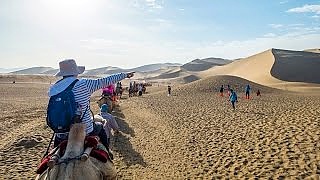
DunHuang is situated in a rich oasis within the Gobi Desert that includes Crescent Lake. DunHuang held a strategic position at the crossroads of the ancient Southern Silk Route and the main road leading from India via Lhasa to Mongolia and Southern Siberia, as well as the entrance to the narrow HeXi Corridor, which led straight to the heart of the northern China plains and the ancient capitals of Chang'An (known today as Xi'An) and LuoYang. The Gobi Desert is a 'rain shadow desert', formed by the Himalayan mountain range blocking rain-carrying clouds from the Indian Ocean.
YinChuan, 'Silver River', lies in NingXia province, central - north China. It is located near the western bank of the upper course of the Yellow River, in the south-central section of the HeLan Shan mountains and the Ordos Desert. Thanks to the Yellow River, YinChuan enjoys beautiful natural scenery and favorable conditions for agriculture and has long earned the fame of a "River Side City in the Northwest" and "Home to Fishes and Rice". Around the city of about 2 million are a number of interesting cultural sites, including part of the Great Wall of China (not far from the western end-point) and grand mosques (Hui minority) and lies on a trade route from cities in the far west to the east. Nearby are the extensive Western Xia Dynasty (1038 - 1227) Tombs, 40 kilometers to the west. There are two pagodas in YinChuan that are part of the 'Eight Famous Sceneries of NingXia': one is the HaiBao Pagoda in the northern suburb and the other is the ChengTianSi Pagoda in the west. Sand Lake lies about 50 kilometers north of YinChuan. Being a world of desert and a large lake, it is a place of beautiful nature and a great getaway. The immediate plains area, intensively irrigated by a system developed as long ago as the Han dynasty (206 BC–AD 220), is very productive for agriculture. A great film by Sticker Travel ...
JiaYuGuan 嘉峪关 - the western end of the Great Wall of China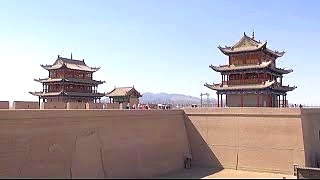
Plus DunHuang oasis and ZhangYe DanXia GeoPark, all in GanSu province.
Two months in China's south west 中国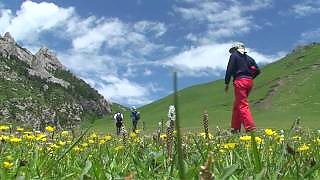
Highlights of an eight week trip though Tibet, YunNan, SiChuan, GanSu and QingHai provinces (2007).
XiaMen, FuJian province, Urumqi, XinJiang province, and DunHuang, GanSu province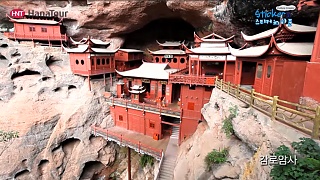
A few of the great China videos by Stick2r ...
DunHuang 敦煌, GanSu province : along the old Silk Road
Explore the beautiful ancient town and surrounding sand-dunes and Buddhist caves with Sticker Travel. The second film shows the Silk Road DunHuang Hotel. DunHuang lies at the eastern end of the old northern Silk Route, from the ancient capital of Xi'An westwards to Kashgar in XinJiang province. The Great Wall was extended westwards to here around 120 BCE during the Han dynasty (202 BCE - 220 AD). During the Han and Tang dynasties, in particular, it was an important point of communication between China and central Asia.
The MaiJiShan Grottoes 麦积山石窟, TianShui, GanSu province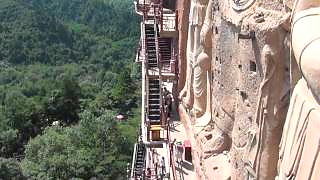
The MaiJiShan Grottoes are filled with thousands of Buddhist sculptures. These were carved from the Wei dynasty to the Song dynasty by Buddhist monks who first came here via the North Silk Road. The grottoes are close to TianShui, which is the second largest city in GanSu province in central China, with a population of approximately 3.5 milion. The city lies along the route of the ancient Northern Silk Road by the Wei River, through which much of the trade flowed between China and the West. The Qin state, the founding dynasty of China, arose in this part of China.
A trip to DunHuang 敦煌 in the Gobi Desert
DunHuang lies within an oasis in the Gobi Desert, GanSu province. It was an important stop along the Silk Road.
A trip to JiaYuGuan 嘉峪关, western end of the Great Wall - video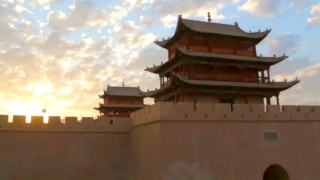
JiaYuGuan is the first pass at the western end of the Great Wall of China. It lies 6 kilometers southwest of the city of JiaYuGuan in GanSu province. The fortress lies between two hills and near to an oasis that was then on the western edge of China. According to legend, when JiaYuGuan was being planned, the official in charge asked the designer to estimate the number of bricks required; the designer surprised the official by giving him an exact number. The official questioned his judgment, asking him if he was sure that would be enough, so the designer added one brick to the total. When JiaYuGuan was finished, there was one brick left over, which was placed loose on one of the gates, where it remains today. Nearby are the DunHuang Caves (also known as the MoGau Caves); these grottoes date from the 4th century AD and contain Buddhist art from over the next thousand years.
Silk Road travels, including JiaYuGuan and DunHuang - video
Scenes along the Silk Road in China. Places include Hohhot (Inner Mongolia), YinChuan (NingXia), LanZhou (Gansu), TianShui (Gansu), ZhangYe (Gansu), JiaYuGuan (Gansu), DunHuang (Gansu), Urumqi (XinJiang). Most notably, the western end of the Great Wall at JiaYuGuan and the Grottoes at DunHuang.
Labrang Monastery, GanSu 甘肃 province
The Labrang Monastery is one of the six great monasteries of the Gelugpa (Yellow Hat) school of Tibetan Buddhism; it stands at the foot of Phoenix Mountain, facing Dragon Mountain.
